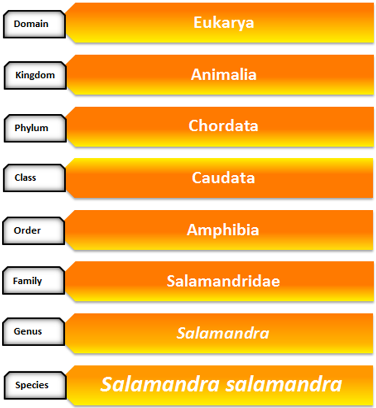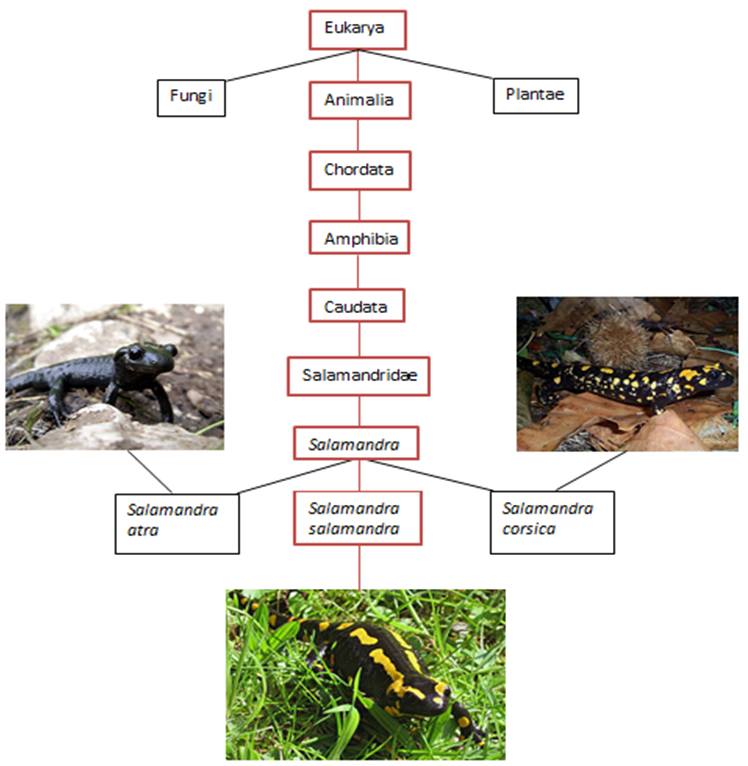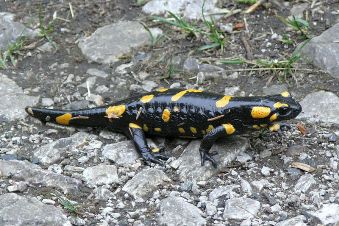Salamandra salamandra - Fire Salamander
Classification

Domain: Eukarya- All organisms containing a true nucleus and membrane bound orgenelles.
Kingdom: Animalia- All
animals are eukaryotic, multicellular, heterotrophic, and are motile at some
stage in life.
Phylum: Chordata- All
vertebrates (animals with a backbone). All chordates share five
unique features: a notochord, a dorsal tubular nerve chord, pharyngeal
gills, an endostyle, and a postanal tail.
Class: Amphibia- The word
amphibia refers to double life, in water and on land. This group
includes around 3000 species of salamanders,
toads,
frogs, and
caecilians. All members in this group are ectothermic and possess
both gills and lungs at some stage in life.
Order: Caudata-
Salamanders, with four limbs, an elongated body, and a tail, their skin is
smooth and glandular for poisonous mucous secretions, and all are
predaceous. The
spotted salamander and the
tiger salamander are a few more examples of a salamander in the
caudata order.
Family: Salamandridae- Consists of all true salamanders and newts. True salamanders are considered to be medium sized, in both terrestrial and aquatic habitats. Most of the 98 species in this family are venomous.
Subfamily: Salamandrinae- A total of 18 species, coming from 4 different genuses: Chioglossa, Lyciasalamandra, Mertensiella, and Salamandra.
Genus: Salamandra-
This genus consists of 6 different Salamandra species of European, North African,
and Asian salamanders.
Species: Salamandra salamandra- European venomous species, which is black with yellow spots or stripes. This scientific name is in Latin, when translated to English, it simply means Salamander salamander. However, in Greek, the word salamander means "fire-lizard".
Common name: Fire Salamander

Pictures in the above phylogeny (from left to
right):
Photo of Salamandra atra, photo by Kabóca via Wikimedia
Commons.
http://commons.wikimedia.org/wiki/Salamandra_atra
Photo of Salamandra salamandra, photo by Michael Linnenbach via
Wikimedia Commons.
http://commons.wikimedia.org/wiki/File:Feuersalamander_portrait.jpg
Photo of Salamandra corsica, photo by Andre de Saint-Paul via
Wikimedia Commons.
http://commons.wikimedia.org/wiki/Salamandra_corsica
Now that we have learned how to classify the fire salamander, let us go take a look at its Habitat.
Return to Home page.

![Phylogenetic Tree of Life. Image by Sting [Public Domain] via Wikimedia Commons](640px-Phylogenetic_tree_scientific_names.svg.png)